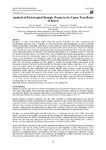| dc.description.abstract | Drought is a major environmental hazard which has serious implications for water management and
environmental protection. This is especially so when unsustainable water management, as well as predicted
climate change effects in droughts, could result in severe impacts on nature and society. Inefficient management
of drought and water resources could put aquatic ecosystems under serious severe stress. The lack of adequate
water availability in rivers during drought episodes leads to heavy overexploitation of the rivers and reservoirs,
which significantly affects the survival of associated biological diversity. It is therefore essential to know the
occurrence of drought events in river basins with a view to establishing and developing measures to minimize
the socioeconomic and environmental impacts of its effects in these areas. In this paper, drought duration and
severity were examined in four homogenous regions of the upper Tana basin. The homogenous regions were
established using principal component analysis results of discharge data from twenty two river gauge stations in
basin. The runs analysis technique was then applied to examine the drought duration and severity at the
homogenous regions of the basin. Results indicated that the mean drought duration varied from 4 to 11 months
across the regions whilst the standardized mean severity ranged from 0.63 to 3.89. Two of the regions
experienced nearly the same standardized mean severity. Drought events occurred at times when the basin
experienced rainfall deficits an indication that low rainfall affects discharge in the rivers of the basin. The
variations in the number and frequency of the drought events in the homogenous regions would possibly be
related to the semi-arid and arid nature of the climate in most of the southern and eastern parts of the basin. To
minimize the impacts of drought in the basin, it is recommended that capacity building of the local communities
in the basin be done focusing on water conservation and alternative livelihoods systems to minimize
overdependence on water resources in the basin. | en_US |

